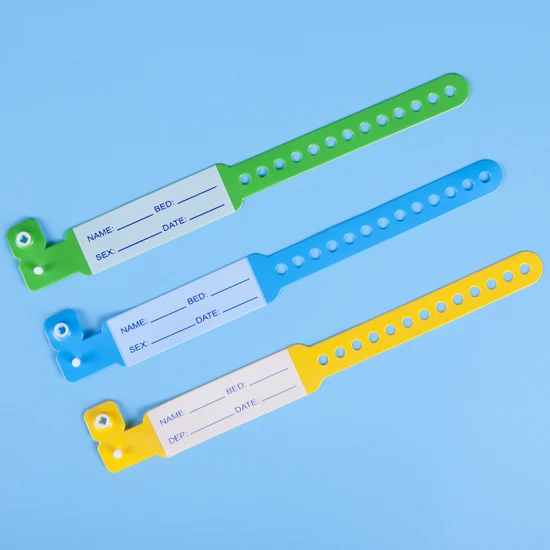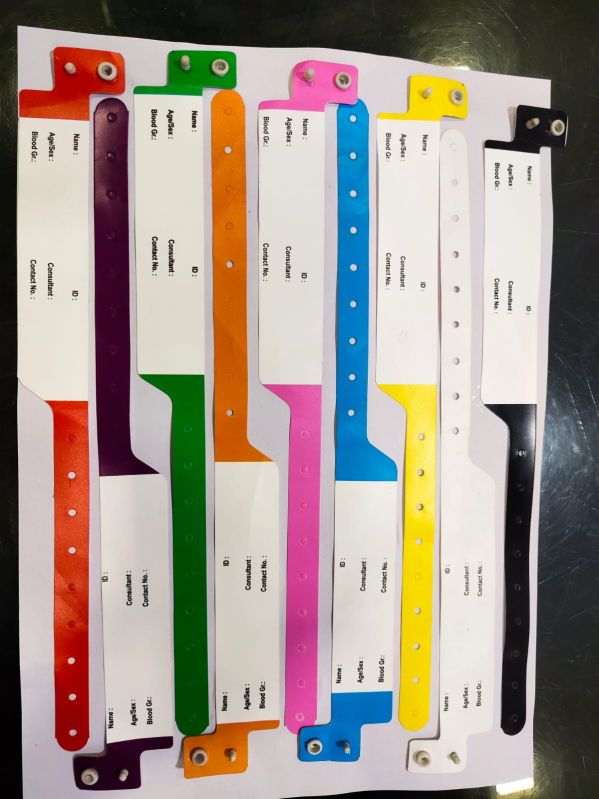Checking Out the Different Kinds Of Patient Identification Band Used in Medical Facilities
In the complex world of health care, the important duty of Patient Identification bands usually goes unnoticed. These bands, varying from basic paper wristbands to innovative RFID bands, develop the foundation of Patient safety methods, making sure precision in Patient Identification.
Comprehending the Importance of Patient Identification Bands
While they may seem like mere devices, Patient Identification bands play a crucial function in clinical centers. These bands offer as a critical device for verifying Patient identity, protecting against medical mistakes associated to misidentification. Patient Identification bands additionally aid in simplifying management tasks, making certain exact record-keeping and invoicing.
Standard Paper Wristbands: Their Use and Limitations
Typical paper wristbands have been a staple in Patient Identification across numerous medical facilities. While their usage prevails, they harbor specific limitations that may impact their efficiency in Patient monitoring. This section will focus on the extent of their application and the inherent downsides connected with their usage.
Paper Wristbands: Use Range
In the realm of Patient Identification, paper wristbands have long held an essential function. These bands are generally utilized in outpatient setups, where the Patient's stay is momentary. The wristbands have essential details such as the Patient's name, day of birth, and an one-of-a-kind Identification number. This straightforward, yet effective system, allows doctor to swiftly and properly recognize people, making certain the appropriate therapy is provided. Paper wristbands are also utilized in emergency scenarios, where quick Identification is vital. Their use reaches events like blood donation drives and mass vaccination programs, better stressing their convenience. In spite of advancements in modern technology, the simple paper wristband stays a cost-efficient and trustworthy remedy for Patient Identification in various health care situations.
Limitations of Paper Wristbands
Regardless of their widespread usage, paper wristbands are not without their disadvantages. Their physical durability is just one of the substantial constraints. Exposure to water, sweat, or misuse can provide them unreadable and even create them to break down. Additionally, paper wristbands typically lack the technological capacities of even more modern-day options, such as barcoding or RFID chips, restricting their capability to just presenting composed information. The inability to update or change the information on the wristband is one more drawback. If the info is transcribed, legibility can be endangered, leading to possible misidentification. Lastly, paper wristbands can trigger discomfort or skin irritation to some individuals, particularly when put on for extended periods.
Barcoded Wristbands: Innovations in Patient Identification
While Patient Identification has actually long been a vital element of healthcare, the advent of barcoded wristbands represents a significant leap ahead. These bands utilize the simplicity of barcoding modern technology, enabling Patient info to be swiftly scanned and accessed. They enhance the rate and accuracy of Patient Identification, decreasing the threat of clinical errors associated with misidentification. Barcoded wristbands are cost-efficient, simple to generate, and eliminate handwriting errors usual with hands-on systems. They are not without restrictions. While they offer improvements over typical bands, the barcode can become worn or smudged, providing it unreadable. Despite this, barcoded wristbands remain a necessary tool in modern-day health care setups, signifying the intersection of modern technology and Patient treatment.
Superhigh Frequency Identification (RFID) Bands: an Action In The Direction Of Futuristic Health Care
The evolution of Patient Identification bands has brought about the emergence of Radio Regularity Identification (RFID) Bands (patient identification band). These innovative gadgets existing key advantages for health care facilities, using an extra reliable and technologically progressed methods of Patient Identification. The application of RFID in health care is a significant step towards a more futuristic approach to Patient monitoring he said and safety
Understanding RFID Bands

RFID Bands: Secret Advantages
Primarily, these bands enhance Patient safety and security by providing precise, rapid Identification, consequently reducing clinical errors. RFID bands can store a vast quantity of Patient information, consisting of clinical background and allergies, allowing personalized treatment. Generally, RFID bands stand for a significant innovation in Patient Identification technology, benefiting both individuals and health care service providers.
Applying RFID in Medical Care
As we step into a technically sophisticated era, the implementation of RFID bands in health care ends up being significantly essential. These bands offer a smooth method to track and determine clients, ensuring their safety and security and boosting efficiency in treatment procedures. RFID bands supply many benefits over standard Identification techniques. They can keep a large quantity of information, consisting of the Patient's case history and therapy strategies, which can be easily accessed by health care service providers. This information helps physicians make educated decisions pertaining to the Patient's treatment plan. Moreover, RFID bands minimize clinical errors by supplying exact Patient Identification, which is essential in stopping misdiagnosis or wrong medicine management. Hence, the execution of RFID bands is a considerable action towards improving Patient security and healthcare delivery.

Color-Coded Wristbands: Helping in Quick and Accurate Diagnosis
In the dynamic environment of a clinical center, color-coded wristbands have emerged as essential devices for swift and exact Identification of a client's medical problem. These wristbands, used by clients, carry certain shades that match to various clinical conditions or standings. Red could suggest allergic reaction dangers, while yellow may symbolize a loss risk. This system is made to supply instant visual hints to doctor, boosting official source Patient security and care high quality. In emergency situation circumstances, using these wristbands enables rapid decision-making. The efficiency of color-coded wristbands depends on the uniformity of color analysis throughout health care institutions, needing typical requirements for regular application.
Approaches for Effective Execution and Management of Patient ID Bands
Attaining optimal use Patient Identification bands requires a well-structured technique for their execution and administration. The very first step involves training all wellness workers on the significance of appropriately applying and reading these bands. Secondly, health centers should standardize making use of ID bands throughout all departments, making sure harmony and decreasing discrepancies. Normal audits needs to be conducted to confirm adherence to plans and to rectify any type of inconsistencies. Patient education is likewise crucial; clients need to recognize the objective of the bands and the requirement for their consistent wear. patient identification band. More hints Lastly, it's crucial to have a backup plan in location, such as barcode scanning or biometrics, to guarantee that Patient Identification is never ever jeopardized.
Verdict
Patient Identification bands are important in medical facilities to guarantee safety and security and accuracy. Effective execution and administration of these bands can significantly lower medical errors, improve effectiveness, and improve general Patient care.
These bands, varying from easy paper wristbands to innovative RFID bands, create the foundation of Patient safety procedures, making sure accuracy in Patient Identification.The development of Patient Identification bands has actually brought concerning the appearance of Radio Regularity Identification (RFID) Bands. In general, RFID bands stand for a considerable innovation in Patient Identification technology, profiting both individuals and healthcare companies.
RFID bands decrease medical errors by providing precise Patient Identification, which is crucial in avoiding misdiagnosis or incorrect medication administration. Patient education is also essential; individuals must understand the objective of the bands and the demand for their continuous wear.